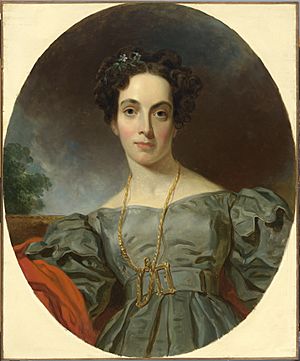Emma Catherine Embury facts for kids
Quick facts for kids
Emma Catherine Embury
|
|
|---|---|

Portrait by Henry Inman
|
|
| Born | Emma Catherine Manley February 25, 1806 New York City, New York, U.S. |
| Died | February 10, 1863 (aged 56) Brooklyn, New York, U.S. |
| Pen name | Ianthe |
| Occupation | author, poet |
| Spouse |
Daniel Embury
(m. 1828) |
| Signature | |
Emma Catherine Embury (born Manley; February 25, 1806 – February 10, 1863) was an American writer and poet. She wrote many poems and stories, often using the pen name "Ianthe". She was one of the first important female writers in the United States. Her works were published in magazines and later collected into books. Some of her famous books include The Blind Girl and Other Tales, Glimpses of Home Life, and Pictures of Early Life. She also wrote Nature’s Gems, or American Wild Flowers (1845) and The Waldorf Family, a fairy tale of Brittany (1848).
Emma Embury's Early Life
Emma Catherine Manley was born in New York City on February 25, 1806. Her father, Dr. James R. Manley, was a well-known doctor in New York. Her mother was Elizabeth Post.
Even as a young child, Emma was very smart. She learned to read almost without being taught. She also showed a talent for writing early on. Her first writings were known for their smooth and beautiful rhythm.
Her Writing Career
By the time she was twenty, Emma began writing regularly for the New York Mirror magazine. She wrote poems and stories especially for young people. Many of her early pieces were published using her pen name, "Ianthe."
On May 10, 1828, she married Daniel Embury, who was a banker in Brooklyn. They had a very happy marriage. Her husband was a talented mathematician. He truly valued Emma's writing skills and always encouraged her to develop them. Together, they had many friends who enjoyed literature and art.
In 1828, Emma Embury published her first book of poems, called Guido, a Tale: Sketches from History and Other Poems. In 1830, she published her first book of stories, Pictures of Early Life. For a while, she was one of two "lady editors" for Graham's Magazine in Philadelphia. The other editor was Ann S. Stephens. During the 1830s and 1840s, Emma often hosted or attended literary gatherings in New York City. She was part of a group that included other famous writers like Anne Lynch Botta and Frances Sargent Osgood.
Emma Embury often said, "Unless she read, she could not write." Her early poems sometimes sounded like the poets she admired most. But later, her own unique style became clear. Her poems were very musical, making her a graceful songwriter. She was also passionate about fairness. She hated injustice and always supported those who were treated unfairly. These feelings often showed up in her poems.
When it came to writing prose (like stories), she mostly wrote for magazines. Her stories were very popular. They were easy to read, often taught a lesson, and were full of cleverness and imagination.
Emma Embury was also an excellent conversationalist. She read widely and remembered a lot of what she read. She could quickly understand new ideas and express herself clearly and beautifully. She was at the center of a large group of friends, including many famous writers. She managed her home well, was a loving wife and mother, and a supportive friend. She spent many years fulfilling these important duties.
In the late 1840s, she became ill. She never fully recovered and spent her last few years as an invalid, mostly staying away from the public. She passed away in Brooklyn on February 10, 1863.
Images for kids


